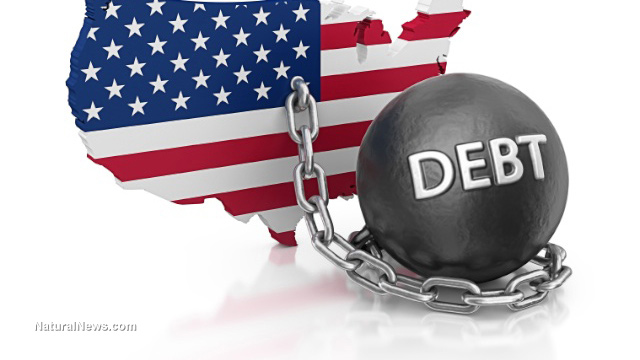U.S. Treasury running out of new buyers of debt, enters debt spiral thanks to reckless government spending
12/06/2023 / By Belle Carter

Analysts are saying that the federal government will continue to pile up debt at astonishing rates, a few weeks into the next fiscal year. Though they believe that there are a lot of factors that brought America into the situation, experts point to the wasteful government spending.
Expenditures increased due to the recent economic downturn but they also saw it increasing at an alarming rate even outside of crisis periods. Mises Wire, a contemporary news and opinion site, reported that government expenditures skyrocketed during the 2020 crisis, but even ignoring those spikes, annual spending has increased by about $1.6 trillion since 2019. Also, tax revenues are not keeping up, which means ever-deepening deficits. Tax receipts have only increased by about $600 billion. And because of this, the administration of President Joe Biden would need to resort to debt to pay for the difference. It went out of control and now the total public debt has ballooned to over $32 trillion, which is over 180 percent of the gross domestic product (GDP). Government spending and transfers were not included in the figure.
To make things worse, the Fed had interest rate hikes. This, combined with the sheer size of the debt has caused the interest payments to increase to historic heights. In 2020, interest payments were a little over $500 billion, and now, they have almost doubled. Also, the Congressional Budget Office (CBO) predicted that interest payments would take up ever-larger portions of the federal budget, causing deficits to nose dive. What happens is that the government needs to borrow more to pay off past debts – an economic doom loop, like what Health Ranger Mike Adams said during one of his recent podcasts on Brighteon.com. (Related: Doug Casey: Entitlements, excessive defense spending and high federal debt interest push U.S. to brink of bankruptcy.)
And now, the U.S. Treasury could not get any more buyers for its debt. The Fed, which has always been a ready buyer of government debt with newly created money, is allowing its holdings of U.S. Treasury securities to roll off its balance sheet. “It cannot resume monetizing the debt without exacerbating price inflation, which is still above its stated target of two percent,” Mises Wire’s Dr. Jonathan Newman wrote in an article. Incidentally, Newman added, foreign governments such as China and Japan are also reducing their purchases of Treasurys, leaving the U.S. with a smaller customer base for its debt. Everybody’s appetite for U.S. government debt is running low, and that includes foreigners, the government’s money printer and favored financial institutions. He cited economist Robert P. Murphy’s recent statement: “The proportion of debt held by foreigners has been declining since 2014.”
Experts: Future looks bleak
Experts and analysts are worried that the future does not look bright, especially since next year, the $7.6 trillion government debt – almost a third of all of America’s outstanding debt – is about to mature. Newman forecasted possible scenarios if the government does not decide to tighten its belt and dramatically reduce spending.
First, he thinks that a financial crisis and official recession will occur. This will give the Fed “permission” to flood the economy with new money and lower interest rates, and make another massive purchase of government debt, as it has in prior crises. “The issue with this scenario is that the Fed is still in the throes of its battle against price inflation. Although some economists say that recent official price inflation statistics show that the Fed is done with its rate hikes, measures of market inflation expectations have remained elevated in the past few months.,” he warned. “We could be heading into 1970s-style stagflation, in which the Fed must choose between dealing with unpopular inflation and unpopular unemployment.”
He also said that treasury auctions may continue to founder. This could further lead to a debt crisis as treasury yields skyrocket and the whole world loses confidence in the country’s ability to repay its debts.
Another possible scenario is that the U.S. government would resort to a “soft default,” similar to its actions in the 1930s and 1971, in which the dollar is transformed to rescue the government from its debt obligations. “One avenue along these lines is the implementation of a central bank digital currency (CBDC). A CBDC could be programmed to have negative interest rates and other incentives that would push CBDC holders to buy government debt. Such a tyrannical move would be disastrous for citizens, but the ability to control interest rates, increase tax revenues, and direct and stimulate spending makes this option very attractive to a debt-riddled government that has painted itself into a corner,” the writer said.
He added that there could be a combination of the forecasts in the years to come. In the video below, he said that the Fed did many unprecedented things in just the past two decades as it used to stretch its power and scope in ways that nobody fully realized it could or would. But he is certain that reckless fiscal and monetary policy has put the U.S. government and the economy in this mess, and the Fed and the government will use the same to try to escape it.
Head over to EconomicRiot.com for updates on the looming financial collapse in America and worldwide.
Sources for this article include:
Submit a correction >>
Tagged Under:
Bubble, budget deficit, CBDC, CBO, Collapse, creditors, crisis, debt bomb, doom loop, economic collapse, economic riot, federal debt, financial downturn, GDP, government debt, government spending, Inflation, interest payments, interest rate hikes, recession, risk, soft default, tax revenues, US Treasury
This article may contain statements that reflect the opinion of the author
Get independent news alerts on natural cures, food lab tests, cannabis medicine, science, robotics, drones, privacy and more from NewsTarget.com
Get independent news alerts on natural cures, food lab tests, cannabis medicine, science, robotics, drones, privacy and more from NewsTarget.com
RECENT NEWS & ARTICLES
COPYRIGHT © 2017 DEBT COLLAPSE NEWS




















